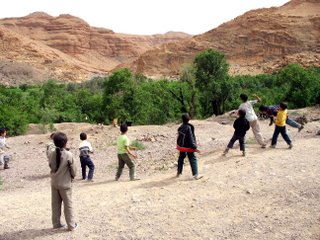
Here's how a house is built in most places in rural Morocco. Although some use concrete, which is expensive just like it is in the states, the traditional way is to build the dirt house. At the risk of overgeneralizing and misinforming my audience, I'll describe the process as the following.
1. You stake your claim to land in the community by birthright. If you were born in the community, you can build whereever you want as long as its approved by a town council. If your an outsider, you have to pay for the land. In the photo, you'll notice these piles of rocks. These are people staking their claim to land. The piles of rocks (which cost about 100 dHm to get delivered) represent future houses or territorial boundaries. When asked, I was told that they're 15 new houses being built within the next year. That's in a village of 40 households.
2. In our village, where there's a house, there's a ditch beside it where the dirt was taken from and used to build the walls (often 12 inches thick) of the house and their perimeter.
3. A crew of 4-5 guys build a house. One gathers the soil, 2 more walk a relay where the soil is shoveled in a bucket, placed on top of their head and then taken to a guy who stands on top of the wall (shown in its beginning stage in the photo). The job of the last guy is to stomp the soil down with an instrument that resembles a lightweight, wide surfaced mallet.
4. Houses are often 10-12 ft high, with their exterior walls being 6-8 ft. Concrete is often used as their floorbase in the interior and elsewhere as needed. The ceilings are wood covered with dirt or something else I haven't figured out yet. Under the wood and dirt of most ceilings is bamboo (which grows very fast), which looks very nice.
5. In all, these dirt houses are cheap, well made, and are environmentally appropriate. For the last month, I've been amazed at how rural Moroccans make the most of their available resources.
(Im pictured in the photo with Mohammad, the owner of the house where we have daily language classes. The wooden gate he's standing in will be filled and packed a little at a time, then moved. After the bottom level is completed, it will be raised and the bottom will be overlaid. This outerwall should be just around 7-8 ft high.











